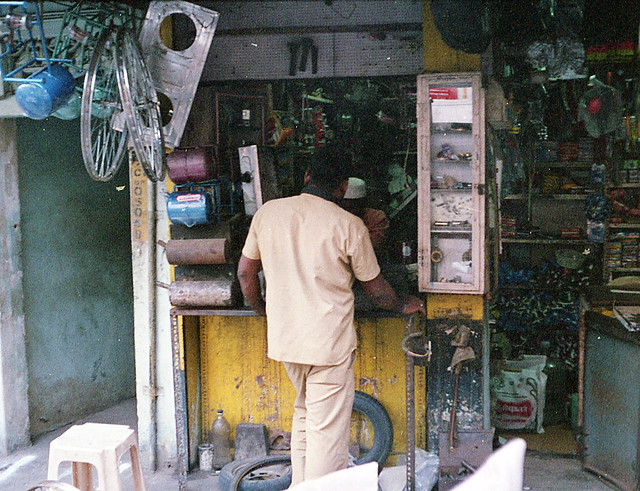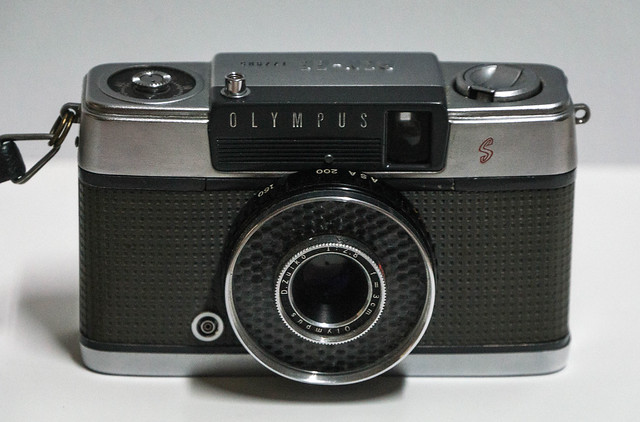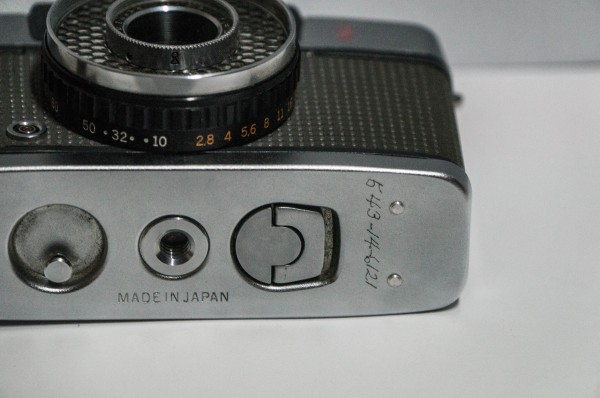A few days ago, I blogged about another vintage camera that I characterized as somewhat unique in that there were virtually no settings or adjustments you could make on the camera. I thought it might be one of the earliest “point and shoot” cameras. Afterward, I realized that virtually every box camera of the early 20th century was in fact a “point and shoot.” But for a folding camera, it was pretty rare to not be able (or have a need to) set the distance from the subject (i.e. focus), aperture and/or shutter speed.
Fast forward to the 1960s, and there is a sudden proliferation of so-called “point and shoot” cameras. Most are pretty cheaply made and simple – think Kodak Instamatics, and all of the plastic Kodaks using 127 film. Most of them, like the box cameras for decades preceding, basically just used a single aperture and shutter speed that would work for most “average” photographic conditions. The Olympus PEN EE.S, pictured here, is a bit more complicated, and could more aptly be called a “fully automatic” camera, as it uses a selenium meter to determine whether the aperture would be f/2.8, , 4, 5.6, 11, 16 or 22; and also whether the shutter speed would be 1/40 or 1/200s. You have to set the film speed (outer dial, see “ASA 200” on photo above) and select between close-up, group, or landscape to focus the camera. It measures the light, and if it can’t come up with a workable aperture and speed setting based on the film speed you’ve selected, the shutter won’t release, and a little red flag shows up in the viewfinder. The only thing that keeps this from being a “fully automatic” camera is the fact that you still have to focus – that feature didn’t appear until 1978, 18 years later than this 1962 camera.
AND it’s a so-called “half-frame” camera – meaning it takes half-size negatives, or 72 photos for the standard 36-exposure 35mm roll.
But this camera is interesting for another reason: it’s got some numbers engraved underneath.
The guy who sold me the camera (via eBay) told me he had bought it at an estate sale, someone named Peter, in Portland Oregon, who had died in his 60s. The numbers on the camera, however, appear to be a social security number. And while social security numbers are generally supposed to be kept private, once you pass away, they can easily be tracked down in the age of the internet. And if you’re lucky, that will lead you to more information. So unless I’m mistaken about those random numbers under the camera, here’s some information about its former owner:
There is additional information here and here, but no mention of anyone named Peter. But presumably at some point, the camera passed from Erwin to somebody named Peter. And regardless, I suppose both of them would have been surprised to know that in 2015, somebody would be using their old camera to take pictures in Chennai, India. But that’s what I did.
Because I assumed the selenium light meter was a little worn out after 50 years, I used ASA 400 film on the ASA 200 setting. I’m not sure if that was sufficient – all of the photos are a little dark and have an odd tint to them which could have something to do with the lens coating? It was pretty easy to fix with a couple of clicks in Photoshop. Here is an example:
(original photo)
(adjusted photo)
The rest of the photos are all “post” Photoshop. But I’d be interested in knowing why they all have the tone of the first photo, if anyone has a clue.
This one is a little grainy – which brings up an important point about half-frame cameras: because the negative is half the size, enlarging the photo will double the graininess of a “normal” 35mm negative.

A few of the photos fade to white at one side – this is a processing error, not the camera.

A couple of problems I had, in addition to the color tint. There’s only one adjustment you need to make on this camera once it’s set up – turn the focus ring to one of three positions. And of course I was so spoiled because of the “automatic” nature of the camera, I kept forgetting to do that. So lots of blurry pictures. If you have one of these, I’d also overcompensate for the older selenium light meter – in other words, make sure the ASA setting on the camera is lower than your actual film. Experiment to figure out what works. And the other error I made: because the standard 35mm exposure is split in two, the aspect ratio is the other way than what you’d expect. In other words, holding the camera horizontal produces a “portrait” photo, not landscape. So that’s something to get used to.
The best part about this camera, besides the number of pictures you can cram onto a roll, is that it’s so darn compact – it fits in your pocket almost like a modern point-and-shoot.
If you’d like to see more of the pictures I took with this camera, refer to this Flickr album. For someone else’s review of the PEN EE.S2, which only differs in that it has a hot shoe, check out this link. And if you have one of these cameras, here’s the manual for it.











Thanks for such a “Blast from the Past”. I had a similar version that Dad brought to my when he came back from Vietnam. Used it ALL THE TIME through High School and into college, and then Dad let me use his Leica through college. (After college went with a Canon AE-1 – now worth about $20 in working condition!) Anyway – before it was stolen in 1989 – I ran some film through it (my Olympus) and had similar weird color results. At the time – I thought I had the ASA set wrong or was using too fast of a film, but never went back to explore what was going on, and do not have the camera anymore.
Thanks for the additional backgrnd! It’s a fun little camera!